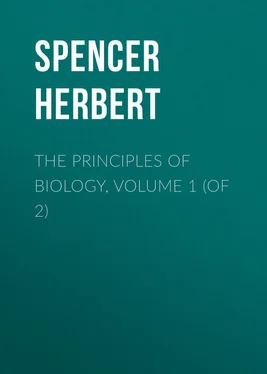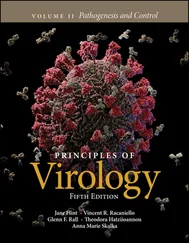Herbert Spencer - The Principles of Biology, Volume 1 (of 2)
Здесь есть возможность читать онлайн «Herbert Spencer - The Principles of Biology, Volume 1 (of 2)» — ознакомительный отрывок электронной книги совершенно бесплатно, а после прочтения отрывка купить полную версию. В некоторых случаях можно слушать аудио, скачать через торрент в формате fb2 и присутствует краткое содержание. Жанр: Философия, foreign_antique, foreign_prose, на английском языке. Описание произведения, (предисловие) а так же отзывы посетителей доступны на портале библиотеки ЛибКат.
- Название:The Principles of Biology, Volume 1 (of 2)
- Автор:
- Жанр:
- Год:неизвестен
- ISBN:нет данных
- Рейтинг книги:3 / 5. Голосов: 1
-
Избранное:Добавить в избранное
- Отзывы:
-
Ваша оценка:
- 60
- 1
- 2
- 3
- 4
- 5
The Principles of Biology, Volume 1 (of 2): краткое содержание, описание и аннотация
Предлагаем к чтению аннотацию, описание, краткое содержание или предисловие (зависит от того, что написал сам автор книги «The Principles of Biology, Volume 1 (of 2)»). Если вы не нашли необходимую информацию о книге — напишите в комментариях, мы постараемся отыскать её.
The Principles of Biology, Volume 1 (of 2) — читать онлайн ознакомительный отрывок
Ниже представлен текст книги, разбитый по страницам. Система сохранения места последней прочитанной страницы, позволяет с удобством читать онлайн бесплатно книгу «The Principles of Biology, Volume 1 (of 2)», без необходимости каждый раз заново искать на чём Вы остановились. Поставьте закладку, и сможете в любой момент перейти на страницу, на которой закончили чтение.
Интервал:
Закладка:
While the relatively great inertia of these large and complex organic molecules renders them comparatively incapable of being set in motion by the ethereal undulations, and so reduced to less coherent forms of aggregation, this same inertia facilitates changes of arrangement among their constituent molecules or atoms; since, in proportion as an incident force impresses but little motion on a mass, it is the better able to impress motion on the parts of the mass in relation to one another. And it is further probable that the extreme contrasts in molecular mobilities among the components of these highly complex molecules, aid in producing modifiability of arrangement among them.
Lastly, the great difference in diffusibility between colloids and crystalloids, makes possible in the tissues of organisms a specially rapid re-distribution of matter and motion; both because colloids, being easily permeable by crystalloids, can be chemically acted on throughout their whole masses, instead of only on their surfaces; and because the products of decomposition, being also crystalloids, can escape as fast as they are produced: leaving room for further transformations. So that while the composite molecules of which organic tissues are built up, possess that low molecular mobility fitting them for plastic purposes, it results from the extreme molecular mobilities of their ultimate constituents, that the waste products of vital activity escape as fast as they are formed.
To all which add that the state of warmth, or increased molecular vibration, in which all the higher organisms are kept, increases these various facilities for re-distribution: not only as aiding chemical changes, but as accelerating the diffusion of crystalloid substances.
CHAPTER II.
THE ACTIONS OF FORCES ON ORGANIC MATTER
§ 10. To some extent, the parts of every body are changed in their arrangement by any incident mechanical force. But in organic bodies, and especially in animal bodies, the changes of arrangement produced by mechanical forces are usually conspicuous. It is a distinctive mark of colloids that they readily yield to pressures and tensions, and that they recover, more or less completely, their original shapes, when the pressures or tensions cease. Evidently without this pliability and elasticity, most organic actions would be impossible. Not only temporary but also permanent alterations of form are facilitated by this colloid character of organic matter. Continued pressure on living tissue, by modifying the processes going on in it (perhaps retarding the absorption of new material to replace the old that has decomposed and diffused away), gradually diminishes and finally destroys its power of resuming the outline it had at first. Thus, generally speaking, the substances composing organisms are modifiable by arrested momentum or by continuous strain, in far greater degrees than are inorganic substances.
§ 11. Sensitiveness to certain forces which are quasi-mechanical, if not mechanical in the usual sense, is seen in two closely-related peculiarities displayed by organic matter as well as other matter which assumes the same state of molecular aggregation.
Colloids take up by a power called "capillary affinity," a large quantity of water: undergoing at the same time great increase of bulk with change of form. Conversely, with like readiness, they give up this water by evaporation; resuming, partially or completely, their original states. Whether resulting from capillarity, or from the relatively great diffusibility of water, or from both, these changes are to be here noted as showing another mode in which the arrangements of parts in organic bodies are affected by mechanical actions.
In what is termed osmose, we have a further mode of an allied kind. When on opposite sides of a permeable septum, and especially a septum of colloidal substance, are placed miscible solutions of different densities, a double transfer takes place: a large quantity of the less dense solution finds its way through the septum into the more dense solution; and a small quantity of the more dense finds its way into the less dense – one result being a considerable increase in the bulk of the more dense at the expense of the less dense. This process, which appears to depend on several conditions, is not yet fully understood. But be the explanation what it may, the process is one that tends continually to work alterations in organic bodies. Through the surfaces of plants and animals, transfers of this kind are ever taking place. Many of the conspicuous changes of form undergone by organic germs, are due mainly to the permeation of their limiting membranes by the surrounding liquids.
It should be added that besides the direct alterations which the imbibition and transmission of water and watery solutions by colloids produce in organic matter, they produce indirect alterations. Being instrumental in conveying into the tissues the agents of chemical change, and conveying out of them the products of chemical change, they aid in carrying on other re-distributions.
§ 12. As elsewhere shown ( First Principles , § 100) heat, or a raised state of molecular vibration, enables incident forces more easily to produce changes of molecular arrangement in organic matter. But besides this, it conduces to certain vital changes in so direct a way as to become their chief cause.
The power of the organic colloids to imbibe water, and to bring along with it into their substance the materials which work transformations, would not be continuously operative if the water imbibed were to remain. It is because it escapes, and is replaced by more water containing more materials, that the succession of changes is maintained. Among the higher animals and higher plants its escape is facilitated by evaporation. And the rate of evaporation is, other things equal, determined by heat. Though the current of sap in a tree is partly dependent on some action, probably osmotic, that goes on in the roots; yet the loss of water from the surfaces of the leaves, and the consequent absorption of more sap into the leaves by capillary attraction, must be a chief cause of the circulation. The drooping of a plant when exposed to the sunshine while the earth round its roots is dry, shows us how evaporation empties the sap-vessels; and the quickness with which a withered slip revives on being placed in water, shows us the part which capillary action plays. In so far, then, as the evaporation from a plant's surface helps to produce currents of sap through the plant, we must regard the heat which produces this evaporation as a part-cause of those re-distributions of matter which these currents effect. In terrestrial animals, heat, by its indirect action as well as by its direct action, similarly aids the changes that are going on. The exhalation of vapour from the lungs and the surface of the skin, forming the chief escape of the water that is swallowed, conduces to the maintenance of those currents through the tissues without which the functions would cease. For though the vascular system distributes nutritive liquids in ramified channels through the body; yet the absorption of these liquids into tissues, partly depends on the escape of liquids which the tissues already contain. Hence, to the extent that such escape is facilitated by evaporation, and this evaporation facilitated by heat, heat becomes an agent of re-distribution in the animal organism. 6
§ 13. Light, which is now known to modify many inorganic compounds – light, which works those chemical changes utilized in photography, causes the combinations of certain gases, alters the molecular arrangements of many crystals, and leaves traces of its action even on substances that are extremely stable, – may be expected to produce marked effects on substances so complex and unstable as those which make up organic bodies. It does produce such effects; and some of them are among the most important that organic matter undergoes.
Читать дальшеИнтервал:
Закладка:
Похожие книги на «The Principles of Biology, Volume 1 (of 2)»
Представляем Вашему вниманию похожие книги на «The Principles of Biology, Volume 1 (of 2)» списком для выбора. Мы отобрали схожую по названию и смыслу литературу в надежде предоставить читателям больше вариантов отыскать новые, интересные, ещё непрочитанные произведения.
Обсуждение, отзывы о книге «The Principles of Biology, Volume 1 (of 2)» и просто собственные мнения читателей. Оставьте ваши комментарии, напишите, что Вы думаете о произведении, его смысле или главных героях. Укажите что конкретно понравилось, а что нет, и почему Вы так считаете.












